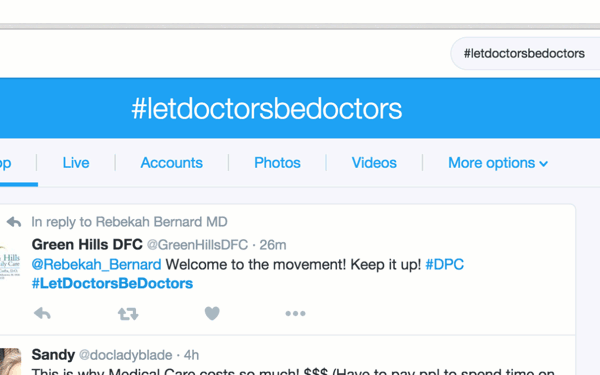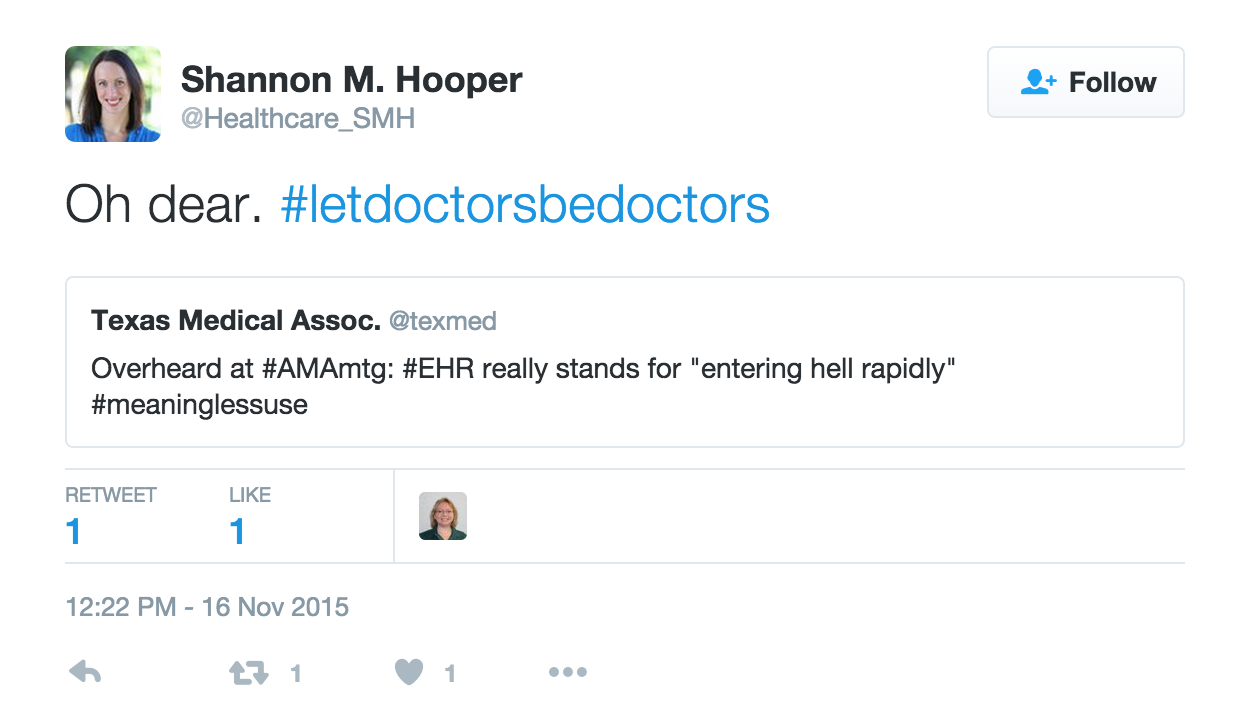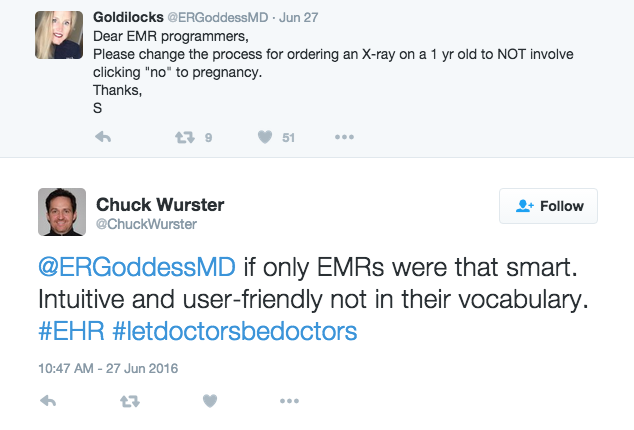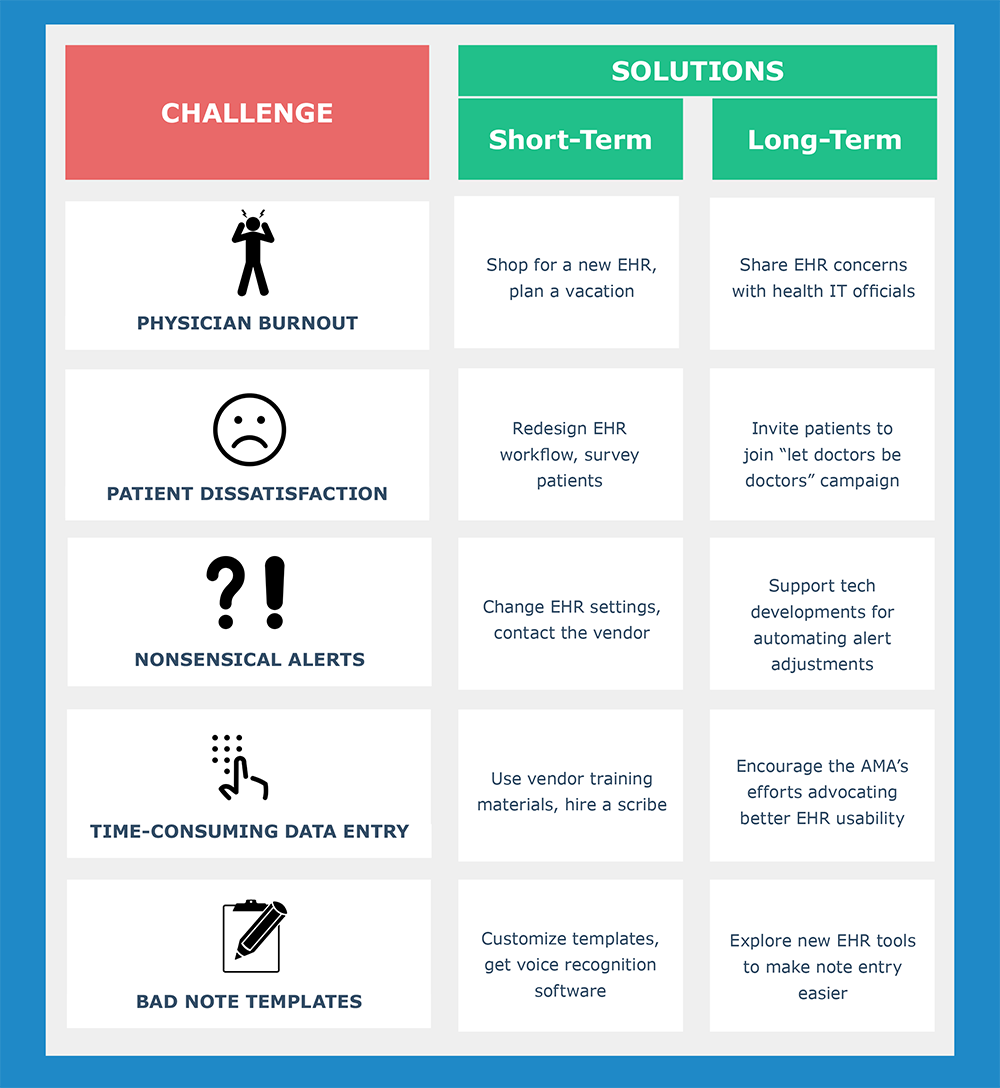#LetDoctorsBeDoctors: 5 Funny Tweets To Spur EHR Improvements
Doctors who hate EHRs now have a rallying cry: “Let doctors be doctors”.
Medical professionals are regularly using the phrase on social media to vent about health IT inefficiencies and brainstorm potential solutions. The phrase inspired trending Twitter hashtags, memes and this brilliant piece of satire from an actual physician:
“EHR State of Mind” by ZDoggMD
We interviewed ZDoggMD himself and compiled the five funniest #letdoctorsbedoctors tweets to find out how and why EHRs should improve. This article also provides tips for choosing software that won’t disappoint doctors.
Click on a section below to start laughing and learning.
Introduction: How “Let Doctors Be Doctors” Went Viral
Tweet 1: @Healthcare_SMH Learns The Other Meaning Of “EHR”
Tweet 2: @dlschermd Shares Cartoon Of Bloody Patient Vs EHR
Tweet 3: Nonsensical Alerts Confuse @ERGoddessMD and @ChuckWurster
Tweet 4: For @drnickUSA, Time Flies When You’re Entering EHR Data
Tweet 5: @diberri Breaks Out The Tissues Due To Bad Note Templates
Conclusion: How To Get An EHR You Actually Like
Introduction: How “Let Doctors Be Doctors” Went Viral
Search the “let doctors be doctors” hashtag on Twitter and you’ll end up scrolling through a stream of tweets that goes back several months:

New #letdoctorsbedoctors tweets appear almost daily
The tweets show a great deal of resentment toward health IT, with many frustrated physicians saying they’re spending too much time struggling with clunky electronic records software instead of treating patients.
The EHR backlash spurred by #letdoctorsbedoctors stems from an unlikely source: EHR vendor athenahealth.
“Let Doctors Be Doctors” started as an athenahealth marketing campaign in October 2015 featuring a series of ads, surveys, social media promotion and a dedicated website meant to give the provider community a platform to share their honest feedback about EHRs.
While EHRs do have significant benefits, this campaign has clearly struck a chord with health care providers. ZDoggMD, the rapper whose YouTube video we featured at the top of this article, was a practicing hospitalist for 10 years. He partnered with athenahealth for the campaign and says it has allowed dissatisfied software users to find like-minded peers online, band together and brainstorm solutions for improvements.

“[There’s been] A LOT more open discussion about usability and interoperability. A lot more physician, nurse, and clinician voices piping up to give input on how we can improve the state of EHR in the country to serve the clinician-patient relationship.”
ZDoggMD (AKA Dr. Zubin Damania)
The tweets highlighted below are just a few of those voices, but they represent major reasons some doctors disdain EHRs. Keep reading to see if you relate to any of these challenges and to find out how your team can overcome them.
Tweet 1: @Healthcare_SMH Learns The Other Meaning Of EHR

Why it’s funny but true:
Not all EHRs feel like raging infernos, but many doctors are getting burned out dealing with burdensome systems. Mayo Clinic researchers recently found physicians who use EHRs have “lower satisfaction with the amount of time spent on clerical tasks and higher rates of burnout.” This creates a stressful work environment that can erode morale throughout the entire practice.
What to do about it now:
Shop around for a more user-friendly EHR
Believe it or not, lots of doctors love their EHR because the intuitive interface and helpful functionalities make the administrative parts of their job more tolerable. But don’t take my word for it—see why real physicians gave these five EHRs top ratings for usability.
Plan a vacation
Taking a break helps alleviate burnout so you can return to the practice feeling refreshed and motivated. We know it’s not easy to arrange time off, especially for small practices, which is why we put together this vacation planning guide for physicians.
Signs of hope for change:
Take a look at the “meaningless use” hashtag in @texmed’s tweet—that’s a reference to Meaningful Use (MU), a multi-stage government program that offers financial incentives to EHR-using practices. After hearing loud complaints from the industry about MU’s requirements, health officials have decided to replace the initiative. This shows your feedback is not falling on deaf ears.
Tweet 2: @dlschermd Shares Cartoon of Bloody Patient Vs EHR
#LetDoctorsBeDoctors pic.twitter.com/UZbtvtk7ue
— David Lee Scher, MD (@dlschermd) February 6, 2016
Why it’s funny but true:
A 2013 study published by the National Center for Biotechnology Information discovered emergency room doctors spent an average of 44 percent of their time on data entry, compared to 28 percent on direct patient contact. This is concerning because it can make patients feel neglected. It can also lead to misdiagnoses if physicians don’t spend enough time talking to or observing the people they’re treating.
What to do about it now:
Redesign your workflow to ensure the EHR enhances patient experiences
The problem here isn’t necessarily your EHR. A Software Advice survey of U.S. patients showed 82 percent wouldn’t care if their doctor typed medical notes on a computer during an office exam. The trick is balancing data entry with patient face time, which you can do by adjusting your workflow (e.g., saving some of the more detailed note entry until after the patient has left the room).
Survey patients to assess their satisfaction
If you’re concerned that your bedside manner is suffering as a result of an EHR implementation, send out a patient survey requesting feedback. The results can help you prioritize areas for improvement and boost patient confidence in your practice’s use of technology.
Signs of hope for change:
The “let doctors be doctors” movement is particularly promising because it appeals to the general population—not just medical professionals. For example, some patients are passionately protesting the lack of interoperability between EHR systems. “Patients are jumping on board [the campaign], demanding that record systems talk to each other and demanding that their doctors stop being forced to treat a computer screen rather than the patient in front of them,” says ZDoggMD.
Tweet 3: Nonsensical Alerts Confuse @ERGoddessMD and @ChuckWurster

Note: the terms “EMR” and “EHR” are often used interchangeably to describe medical software for digitizing patient records
Why it’s funny but true:
The U.S. Department of Health and Human Services recognizes that EHR alerts “are only moderately effective at best” because they pop up too often, leading clinicians to get alert fatigue and override many of them. As these tweets show, it can also be frustrating to receive notifications that are obviously out of context or inappropriate for the patient’s situation.
What to do about it now:
Change the system settings
Most systems allow administrators to classify warnings based on how important they are and who they’re intended for (e.g., physicians may want fewer alerts than nurse practitioners). You can then opt to filter these warnings so that only the most relevant and critical alerts appear for each user.
Contact the vendor
You may be able to work directly with your vendor to further cut down on the amount and type of alerts your practice is receiving. Even if the vendor is not as supportive as you’d like, your feedback can at least help them identify areas for improvement into the next system update.
Signs of hope for change:
A research scientist with the Department of Veterans Affairs is studying how to design systems that “take human behavior and supplemental patient data into account when writing rules that decide when and why an alert is fired off.” This would be ideal, as EHRs of the future could automatically learn from your workflow instead of requiring manual adjustments or vendor outreach.
Tweet 4: For @drnickUSA, Time Flies When You’re Entering EHR Data
How did we let this happen? @kksheld @IP4PI @AAPSonline #LetDoctorsBeDoctors @AmerMedicalAssn StopTalkinStartFightin pic.twitter.com/TPqn8pD9YK
— Nicholas DiNubile MD (@drnickUSA) March 3, 2016
Why it’s funny but true:
Hardly anyone sees data entry as a job perk, but it’s especially burdensome for doctors who need to run a tight schedule so they can see enough patients per day to cover costs. While the purpose of EHRs is to make practices more efficient, the learning curve can be steep. Experts recommend setting aside capital to make up for any drops in productivity while a practice gets used to the new workflow.
What doctors can do about it now:
Explore the vendor’s training materials
Often, vendors have more resources than your realize to help cut down on the time you spend entering data. Online training catalogues, webinars and support communities can teach you tricks to improve speed. (Click here for a side by side comparison of two popular EHR vendors’ support and training offerings.)
Hire a scribe
This is the easiest way to avoid entering data while making sure it still gets done. The scribe is in charge of dealing with EHR documentation, which you can tweak and approve as needed. Experts say physicians who use scribes see one additional patient per hour on average.
Signs of hope for change:
While it’s important for physicians to be proactive EHR users, there’s no denying the EHRs themselves need to be faster and more intuitive. That’s why the American Medical Association is engaged in a “multi-stakeholder effort” to work for better-designed systems. The fact that an organization as large and influential as the AMA is advocating on behalf of this issue makes progress much easier to achieve.
Tweet 5: @diberri Breaks Out The Kleenex Due To Bad Note Templates
If you need a good cry, read a modern, templated, EHR physician note. That is all. #letdoctorsbedoctors
— Dave (@diberri) April 29, 2016
Why it’s funny but true:
Unfortunately, some systems have awful note templates. They either have too many fields or too few, and are not specialty-specific, so multispecialty practices are stuck with a one-size-fits-all format. The American Health Information Management Association observes this has led to a rise in duplicate notes, where one doctor copies information from a previous encounter and pastes it to a new note so it seems current. This means that new information is hard to find and potential documentation errors get passed down.
What doctors can do about it now:
Customize your note templates
Depending on the level of customization requested, you may be able to tailor note templates to your needs for free. All you have to do is ask the vendor. In a Software Advice study of EHR buyers, one-quarter of our sample specifically cited customizable note templates as a top-requested functionality.
Get voice recognition software
Dictating notes instead of typing them out is often easier and faster, usually resulting in more detailed documentation. Make sure your EHR software is able to integrate with stand-alone voice recognition systems before making any purchase decisions.
Signs of hope for change:
Vendors are getting savvier every year when it comes to formatting note-writing modules. They are incorporating tools, such as narrative note buttons, drop-down menus, radio buttons, check boxes and open text fields, to give doctors numerous options for both structured and unstructured note entry. The continued development of these options (and your ability to customize their placement) will increasingly lead to better templates.
Conclusion: How To Get An EHR You Actually Like
ZDoggMD says significant change in the EHR industry is on the horizon, but it will take coordinated efforts from multiple entities to achieve it.

“Regulations and payor restrictions have to change, financial incentives have to reward outcomes and usability. It will take a while [for EHR improvements], but there is such outrage in the medical community that there will really be no choice.” Tweet this quote
ZDoggMD (AKA Dr. Zubin Damania)
In the meantime, your EHR solution doesn’t have to feel like a problem. Here’s a recap of the common challenges and potential solutions we identified in this article:

Of course, the best thing for your practice to do if you really despise your EHR is to replace it (provided your budget allows the expense). Below are some steps you can take to find a system you actually like using.
Fill out this online questionnaire. Once you answer a few questions, we’ll automatically recommend up to five EHRs that fit your unique needs.
Email me at gaby@softwareadvice.com. Tell me the pain points you’re experiencing with your current system and I’ll connect you to one of our expert software advisors for a free and fast, no-obligation consultation.
Check out real user reviews to find the right solution on our website. We provide ratings for a number of categories, from functionality to support, so you can gauge how satisfied your colleagues are with certain products.